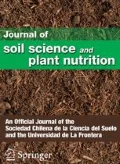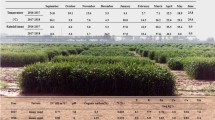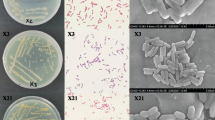Abstract
Application of phosphate-solubilizing bacteria (PSB) to improve phosphorus (P) nutrition of plants under conditions of P deficit in soil has been frequently studied in controlled conditions. However, little research attention has been paid to studying the combined effects of PSB and P fertilizer on improving P uptake and yield of rainfed wheat plant under natural conditions in arid and semi-arid regions including drylands. Field experiments were arranged in a randomized complete block design with a 3 × 4 × 2 × 2 factorial arrangement of treatments with three replications during years 2017–2018 (Y1) and 2018–2019 (Y2) (at four fields) at two various locations (Qazvin and Zanjan). Experimental treatments included P fertilizer factor at three levels: no fertilizer (P0), triple superphosphate (TSP) fertilizer at 10 kg P ha−1 (P10), and TSP fertilizer at 20 kg P ha−1 (P20) and four variants of PSB factor: no inoculation (B0), inoculation with Pseudomonas baetica B21 (B1), inoculation with Pseudomonas helmanticensis B30 (B2), and co-inoculation with B21 and B30 (B3). The results of this study showed that the growth indices and P nutrition of rainfed wheat in dryland fields were affected by the time and location of planting. The application of 20 kg P ha−1 and single inoculation and co-inoculation of wheat with bacterial strains had a significant (p ≤ 0.05) impact on reduced electrolyte leakage. However, the application of 20 kg P ha−1 and single inoculation and co-inoculation of wheat with strains B21 and B30 showed a significant (p ≤ 0.05) effect on increased relative water content, chlorophyll index, proline content, plant height, shoot dry weight, thousand grain weight, and the concentration of shoot and grain P. As a result, application of 20 kg P ha−1 and single inoculation and co-inoculation of wheat with strains B21 and B30 increased grain yield by 63, 43, 52, and 58%, respectively. However, the pattern of these fluctuations differed in different years and locations. The significant enhancement of biomass parameters and grain yield of rainfed wheat by co-inoculation of PSB in combination with 20 kg P ha−1 strongly supports the use of Pseudomonas strains as a biofertilizer for improving the wheat growth and grain yield in rainfed farming systems. The results of this study also highlight the importance of simultaneous introduction of phosphate fertilizer and PSB for improving plant performance under drought stress.





Similar content being viewed by others
Abbreviations
- ACC:
-
1–Aminocyclopropane–1–carboxylate
- CFU:
-
Colony forming units
- Chl:
-
Chlorophyll
- EL:
-
Electrolyte leakage
- GDW:
-
Grain dry weight
- GPC:
-
Grain P concentration
- GPU:
-
Grain P uptake
- IAA:
-
Indole–3–acetic acid
- MDA:
-
Malondialdehyde
- P:
-
Phosphorus
- PGP:
-
Plant growth promoting
- PGPR:
-
Plant growth–promoting rhizobacteria
- PHe:
-
Plant height
- PSB:
-
Phosphate-solubilizing bacteria
- Q:
-
Qazvin location
- ROS:
-
Reactive oxygen species
- RWC:
-
Relative water content
- SDW:
-
Shoot dry weight
- SPC:
-
Shoot P concentration
- SPU:
-
Shoot P uptake
- TGW:
-
Thousand grain weight
- TSP:
-
Triple superphosphate fertilizer
- Y1:
-
The first wheat cultivation year
- Y2:
-
The second wheat cultivation year
- Z:
-
Zanjan location
References
Ahmad M, Adil Z, Hussain A, Mumtaz MZ, Nafees M, Ahmad I, Jamil M (2019) Potential of phosphate solubilizing Bacillus strains for improving growth and nutrient uptake in mungbean and maize crops. Pak J Agric Sci 56(2)
Ahmed M, Khan S, Irfan M, Aslam MA, Shabbir G, Ahmad S (2018) Effect of phosphorus on root signaling of wheat under different water regimes. Global wheat production:1
Alori ET, Glick BR, Babalola OO (2017) Microbial phosphorus solubilization and its potential for use in sustainable agriculture. Front Microbiol 8:971
Altinkut A, Kazan K, Ipekci Z, Gozukirmizi N (2001) Tolerance to paraquat is correlated with the traits associated with water stress tolerance in segregating F2 populations of barley and wheat. Euphytica 121(1):81–86
Amini S, Ghobadi C, Yamchi A (2015) Proline accumulation and osmotic stress: an overview of P5CS gene in plants. J Plant Mol Breed 3(2):44–55
Anjum SA, Ashraf U, Tanveer M, Khan I, Hussain S, Shahzad B, Zohaib A, Abbas F, Saleem MF, Ali I (2017) Drought induced changes in growth, osmolyte accumulation and antioxidant metabolism of three maize hybrids. Frontiers in Plant Science 8
Asseng S, Pannell DJ (2013) Adapting dryland agriculture to climate change: farming implications and research and development needs in Western Australia. Clim Chang 118(2):167–181
Bashan Y, Kamnev AA, de-Bashan LE (2013) Tricalcium phosphate is inappropriate as a universal selection factor for isolating and testing phosphate-solubilizing bacteria that enhance plant growth: a proposal for an alternative procedure. Biol Fertil Soils 49 (4):465–479
Bates LS, Waldren RP, Teare I (1973) Rapid determination of free proline for water-stress studies. Plant Soil 39(1):205–207
Beltrano J, Ronco MG (2008) Improved tolerance of wheat plants (Triticum aestivum L.) to drought stress and rewatering by the arbuscular mycorrhizal fungus Glomus claroideum: effect on growth and cell membrane stability. Braz J Plant Physiol 20(1):29–37
Boroumand N, Behbahani M, Dini G (2020) Combined effects of phosphate solubilizing bacteria and nanosilica on the growth of land cress plant. J Soil Sci Plant Nutr 20(1):232–243
Canarini A, Wanek W, Merchant A, Richter A, Kaiser C (2019) Root exudation of primary metabolites: mechanisms and their roles in plant responses to environmental stimuli. Front Plant Sci 10:157
EMG U (2011) Global drylands: a UN system-wide response. Environment Management Group of the United Nations Geneva Retrieved from http://www.unccdint/Lists/SiteDocumentLibrary/Publications/Global_Drylands_Full_Reportpdf
Etesami H (2020a) Chapter 15 - plant–microbe interactions in plants and stress tolerance. In: Tripathi DK, Pratap Singh V, Chauhan DK et al. (eds) Plant life under changing environment. Academic Press, pp 355–396. doi: https://doi.org/10.1016/B978-0-12-818204-8.00018-7
Etesami H (2020b) Enhanced phosphorus fertilizer use efficiency with microorganisms. In: Nutrient Dynamics for sustainable crop production. Springer, pp 215–245
Etesami H, Alikhani HA (2016) Co-inoculation with endophytic and rhizosphere bacteria allows reduced application rates of N-fertilizer for rice plant. Rhizosphere 2:5–12. https://doi.org/10.1016/j.rhisph.2016.09.003
Etesami H, Beattie GA (2018) Mining halophytes for plant growth-promoting halotolerant bacteria to enhance the salinity tolerance of non-halophytic crops. Front Microbiol 9:148
Etesami H, Glick BR (2020) Halotolerant plant growth–promoting bacteria: prospects for alleviating salinity stress in plants. Environmental and Experimental Botany:104124. doi: https://doi.org/10.1016/j.envexpbot.2020.104124
Etesami H, Maheshwari DK (2018) Use of plant growth promoting rhizobacteria (PGPRs) with multiple plant growth promoting traits in stress agriculture: action mechanisms and future prospects. Ecotoxicol Environ Saf 156:225–246. https://doi.org/10.1016/j.ecoenv.2018.03.013
Etesami H, Mirsyed Hosseini H, Alikhani HA (2014) In planta selection of plant growth promoting endophytic bacteria for rice (Oryza sativa L.). J Soil Sci Plant Nutr 14(2):491–503
Etesami H, Alikhani HA, Hosseini HM (2015) Indole-3-acetic acid and 1-aminocyclopropane-1-carboxylate deaminase: bacterial traits required in rhizosphere, rhizoplane and/or endophytic competence by beneficial bacteria. In: Bacterial metabolites in sustainable agroecosystem. Springer, pp 183–258
Etesami H, Emami S, Alikhani HA (2017) Potassium solubilizing bacteria (KSB):: mechanisms, promotion of plant growth, and future prospects A review. J Soil Sci Plant Nutr 17(4):897–911
Farshadfar E, Rasoli V, Teixeira da Silva JA, Farshadfar M (2011) Inheritance of drought tolerance indicators in bread wheat (‘Triticum aestivum’ L.) using a diallel technique. Aust J Crop Sci 5(7):870
Ghorchiani M, Etesami H, Alikhani HA (2018) Improvement of growth and yield of maize under water stress by co-inoculating an arbuscular mycorrhizal fungus and a plant growth promoting rhizobacterium together with phosphate fertilizers. Agric Ecosyst Environ 258:59–70. https://doi.org/10.1016/j.agee.2018.02.016
Godfray HCJ, Beddington JR, Crute IR, Haddad L, Lawrence D, Muir JF, Pretty J, Robinson S, Thomas SM, Toulmin C (2010) Food security: the challenge of feeding 9 billion people. Science 327(5967):812–818
Gratani L, Varone L (2004) Leaf key traits of Erica arborea L., Erica multiflora L. and Rosmarinus officinalis L. co-occurring in the Mediterranean maquis. Flora-Morphol, Distrib, Funct Ecol Plants 199(1):58–69
Guimarães ER, Mutton MA, Mutton MJR, Ferro MIT, Ravaneli GC, Silva JAd (2008) Free proline accumulation in sugarcane under water restriction and spittlebug infestation. Sci Agric 65 (6):628–633
Gupta NK, Gupta S, Kumar A (2001) Effect of water stress on physiological attributes and their relationship with growth and yield of wheat cultivars at different stages. J Agron Crop Sci 186(1):55–62
Harmsen K, Matar AE, Saxena MC, Silim SN (2001) Yield response to phosphorus fertilizer in a wheat-lentil rotation in a Mediterranean environment. NJAS-Wageningen J Life Sci 49(4):385–403
Jambunathan N (2010) Determination and detection of reactive oxygen species (ROS), lipid peroxidation, and electrolyte leakage in plants. In: Plant stress tolerance. Springer, pp 291–297
Jeshni MG, Mousavinik M, Khammari I, Rahimi M (2017) The changes of yield and essential oil components of German Chamomile (Matricaria recutita L.) under application of phosphorus and zinc fertilizers and drought stress conditions. J Saudi Soc Agric Sci 16(1):60–65
Jungklang J, Saengnil K, Uthaibutra J (2017) Effects of water-deficit stress and paclobutrazol on growth, relative water content, electrolyte leakage, proline content and some antioxidant changes in Curcuma alismatifolia Gagnep. cv. Chiang Mai Pink. Saudi J Biol Sci 24(7):1505–1512
Kadioglu A, Saruhan N, Sağlam A, Terzi R, Acet T (2011) Exogenous salicylic acid alleviates effects of long term drought stress and delays leaf rolling by inducing antioxidant system. Plant Growth Regul 64(1):27–37
Kang S-M, Khan AL, Waqas M, You Y-H, Kim J-H, Kim J-G, Hamayun M, Lee I-J (2014) Plant growth-promoting rhizobacteria reduce adverse effects of salinity and osmotic stress by regulating phytohormones and antioxidants in Cucumis sativus. J Plant Interact 9(1):673–682
Karimzadeh J, Alikhani HA, Etesami H, Pourbabaei AA (2020) Improved phosphorus uptake by wheat plant (Triticum aestivum L.) with rhizosphere fluorescent Pseudomonads strains under water-deficit stress. J Plant Growth Regul. https://doi.org/10.1007/s00344-020-10087-3
Khan A, Jilani G, Zhang D, Akbar S, Malik KM, Rukh S, Mujtaba G (2020) Acidithiobacillus thiooxidans IW16 and sulfur synergistically with struvite aggrandize the phosphorus bioavailability to wheat in alkaline soil. J Soil Sci Plant Nutr 20(1):95–104
Koohafkan P, Stewart B (2008) Water and cereals in drylands, 113pp. The Food and Agriculture Organization of the United Nations and Earthscan, London-Sterling, VA, UK
Kumar A (2014) Textbook of plant nutrient management. Indian J Agron 59(4):676–676
Kumar A, Maurya BR, Raghuwanshi R (2014) Isolation and characterization of PGPR and their effect on growth, yield and nutrient content in wheat (Triticum aestivum L.). Biocatalys Agric Biotechnol 3(4):121–128
Liang X, Zhang L, Natarajan SK, Becker DF (2013) Proline mechanisms of stress survival. Antioxid Redox Signal 19(9):998–1011
Maestre FT, Delgado-Baquerizo M, Jeffries TC, Eldridge DJ, Ochoa V, Gozalo B, Quero JL, Garcia-Gomez M, Gallardo A, Ulrich W (2015) Increasing aridity reduces soil microbial diversity and abundance in global drylands. Proc Natl Acad Sci 112(51):15684–15689
Malik MA, Khan KS, Marschner P (2013) Microbial biomass, nutrient availability and nutrient uptake by wheat in two soils with organic amendments. J Soil Sci Plant Nutr 13(4):955–966
Marti J, Slafer GA (2014) Bread and durum wheat yields under a wide range of environmental conditions. Field Crop Res 156:258–271
McBeath T, McLaughlin M, Kirby J, Armstrong R (2012) The effect of soil water status on fertiliser, topsoil and subsoil phosphorus utilisation by wheat. Plant Soil 358(1–2):337–348
McLaughlin MJ, McBeath TM, Smernik R, Stacey SP, Ajiboye B, Guppy C (2011) The chemical nature of P accumulation in agricultural soils—implications for fertiliser management and design: an Australian perspective. Plant Soil 349(1–2):69–87
Mezaache-Aichour S, Guechi A, Nicklin J, Drider D, Prevost H, Strange R (2012) Isolation, identification and antimicrobial activity of pseudomonads isolated from the rhizosphere of potatoes growing in Algeria. J Plant Pathol 94(1):89–98
Noori F, Etesami H, Najafi Zarini H, Khoshkholgh-Sima NA, Hosseini Salekdeh G, Alishahi F (2018) Mining alfalfa (Medicago sativa L.) nodules for salinity tolerant non-rhizobial bacteria to improve growth of alfalfa under salinity stress. Ecotoxicol Environ Saf 162:129–138. https://doi.org/10.1016/j.ecoenv.2018.06.092
Ojha R, Sarkar A, Aryal A, Rahul KC, Tiwari S, Poudel M, Pant KR, Shrestha J (2018) Correlation and path coefficient analysis of wheat (Triticum aestivum L.) genotypes. Farming Manag 3(2):136–141
Ozturk L, Eker S, Torun B, Cakmak I (2005) Variation in phosphorus efficiency among 73 bread and durum wheat genotypes grown in a phosphorus-deficient calcareous soil. Plant Soil 269(1–2):69–80
Parastesh F, Alikhani HA, Etesami H (2019) Vermicompost enriched with phosphate–solubilizing bacteria provides plant with enough phosphorus in a sequential cropping under calcareous soil conditions. J Clean Prod 221:27–37
Pereyra MA, García P, Colabelli MN, Barassi CA, Creus CM (2012) A better water status in wheat seedlings induced by Azospirillum under osmotic stress is related to morphological changes in xylem vessels of the coleoptile. Appl Soil Ecol 53:94–97
Qaseem MF, Qureshi R, Shaheen H (2019) Effects of pre-anthesis drought, heat and their combination on the growth, yield and physiology of diverse wheat (Triticum aestivum L.) genotypes varying in sensitivity to heat and drought stress. Sci Rep 9(1):1–12
Rady MM, El-Shewy AA, El-Yazal MAS, El-Gawwad IFMA (2019) Integrative application of soil P-solubilizing bacteria and foliar nano P improves Phaseolus vulgaris plant performance and antioxidative defense system components under calcareous soil conditions. J Soil Sci Plant Nutr:1–20
Rahimi S, Pirzad A, Jalilian J (2016) Effect of biological and chemical phosphorus on yield and some physiological responses of pot marigold (calendula officinalis L.) under water deficit stress. Biotechnol Ind J 12(12):117
Rao CS, Gopinath K, Rao CR, Raju B, Rejani R, Venkatesh G, Kumari VV (2016) Dryland agriculture in South Asia: experiences, challenges and opportunities. In: Innovations in Dryland Agriculture. Springer, pp 345–392
Rockström J, Lannerstad M, Falkenmark M (2007) Assessing the water challenge of a new green revolution in developing countries. Proc Natl Acad Sci 104(15):6253–6260
Rodriguez D, Goudriaan J, Oyarzabal M, Pomar MC (1996) Phosphorus nutrition and water stress tolerance in wheat plants. J Plant Nutr 19(1):29–39
Saber FM, Abdelhafez AA, Hassan EA, Ramadan EM (2015) Characterization of fluorescent pseudomonads isolates and their efficiency on the growth promotion of tomato plant. Ann Agric Sci 60(1):131–140
Scarpellini M, Franzetti L, Galli A (2004) Development of PCR assay to identify Pseudomonas fluorescens and its biotype. FEMS Microbiol Lett 236(2):257–260
Sharma P, Jha AB, Dubey RS, Pessarakli M (2012) Reactive oxygen species, oxidative damage, and antioxidative defense mechanism in plants under stressful conditions. Journal of Botany 2012:1–26
Sharon JA, Hathwaik LT, Glenn GM, Imam SH, Lee CC (2016) Isolation of efficient phosphate solubilizing bacteria capable of enhancing tomato plant growth. J Soil Sci Plant Nutr 16(2):525–536
Sheirdil RA, Hayat R, Zhang X-X, Abbasi NA, Ali S, Ahmed M, Khattak JZK, Ahmad S (2019) Exploring potential soil bacteria for sustainable wheat (Triticum aestivum L.) production. Sustainability 11(12):3361
SÖNMEZ O, Turan V, Kaya C (2016) The effects of sulfur, cattle, and poultry manure addition on soil phosphorus. Turk J Agric For 40(4):536–541
Sood G, Kaushal R, Chauhan A, Gupta S (2018) Indigenous plant-growth-promoting rhizobacteria and chemical fertilisers: impact on wheat (Triticum aestivum) productivity and soil properties in North Western Himalayan region. Crop and Pasture Science 69(5):460–468
Sultenfuss JH, Doyle WJ (1999) Phosphorus for agriculture. Better Crops with Plant Food 83:1–40
Tariq A, Pan K, Olatunji OA, Graciano C, Li Z, Sun F, Sun X, Song D, Chen W, Zhang A (2017) Phosphorous application improves drought tolerance of Phoebe zhennan. Front Plant Sci 8:1561
Ullah N, Ditta A, Khalid A, Mehmood S, Rizwan MS, Ashraf M, Mubeen F, Imtiaz M, Iqbal MM (2019) Integrated effect of algal biochar and plant growth promoting rhizobacteria on physiology and growth of maize under deficit irrigations. Journal of Soil Science and Plant Nutrition:1–11
Upadhyay SK, Singh JS, Singh DP (2011) Exopolysaccharide-producing plant growth-promoting rhizobacteria under salinity condition. Pedosphere 21(2):214–222
Vardharajula S, Zulfikar Ali S, Grover M, Reddy G, Bandi V (2011) Drought-tolerant plant growth promoting Bacillus spp.: effect on growth, osmolytes, and antioxidant status of maize under drought stress. J Plant Interact 6(1):1–14
Vurukonda SSKP, Vardharajula S, Shrivastava M, SkZ A (2016) Enhancement of drought stress tolerance in crops by plant growth promoting rhizobacteria. Microbiol Res 184:13–24
Weatherley P (1950) Studies in the water relations of the cotton plant: I. The field measurement of water deficits in leaves. New Phytol 49(1):81–97
Westerman RL (1990) Soil testing and plant analysis. Number 3: In: Soil Science Society of America Book Series. Inc Madison, Wisconsin, USA
Wezel A, Casagrande M, Celette F, Vian J-F, Ferrer A, Peigné J (2014) Agroecological practices for sustainable agriculture. A review. Agron Sustain Dev 34(1):1–20
Zafar-ul-Hye M, Danish S, Abbas M, Ahmad M, Munir TM (2019) ACC deaminase producing pgpr bacillus amyloliquefaciens and agrobacterium fabrum along with biochar improve wheat productivity under drought stress. Agronomy 9(7):343
Zamani Z, Zeinali H, Masood SJ, Madani H (2014) Effect of nitrogen and phosphorous fertilizers on the yield and secondary metabolites of medicinal plant Rubia tinctorum L. under salinity conditions
Zhang Z, Liu Z, Hu Y, Li W, Fu Z, Ding D, Li H, Qiao M, Tang J (2014) QTL analysis of kernel-related traits in maize using an immortalized F2 population. PLoS One 9(2)
Funding
The authors received financial support from the University of Tehran and the Iran National Science Foundation (INSF) for doing this study.
Author information
Authors and Affiliations
Contributions
All authors have contributed equally to this study.
Corresponding authors
Ethics declarations
Conflict of Interest
The authors declare that they have no conflict of interest.
Additional information
Publisher’s Note
Springer Nature remains neutral with regard to jurisdictional claims in published maps and institutional affiliations.
Rights and permissions
About this article
Cite this article
Shirmohammadi, E., Alikhani, H.A., Pourbabaei, A.A. et al. Improved Phosphorus (P) Uptake and Yield of Rainfed Wheat Fed with P Fertilizer by Drought-Tolerant Phosphate-Solubilizing Fluorescent Pseudomonads Strains: a Field Study in Drylands. J Soil Sci Plant Nutr 20, 2195–2211 (2020). https://doi.org/10.1007/s42729-020-00287-x
Received:
Accepted:
Published:
Issue Date:
DOI: https://doi.org/10.1007/s42729-020-00287-x




